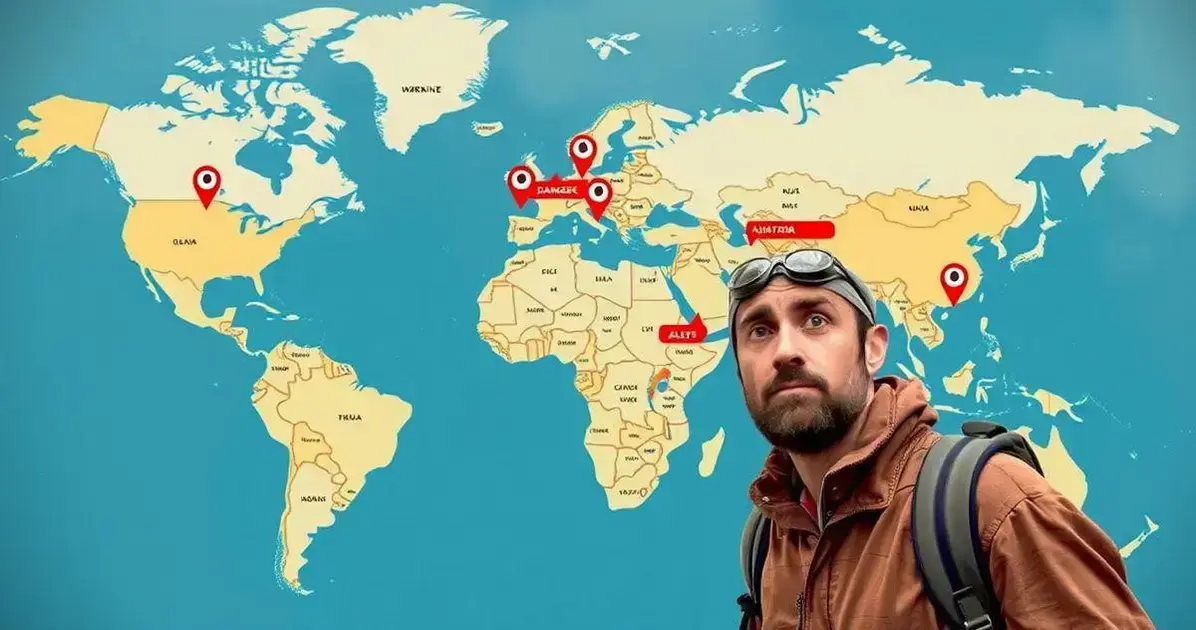Announcements
Travel warnings are government-issued alerts that inform travelers about potential risks in specific areas, such as crime or health issues.
To stay safe, regularly check advisories, assess travel plans, and consider alternative destinations when warnings are issued.
Travel warnings are crucial for every traveler seeking a secure and pleasant journey.
Announcements
They serve as alerts that inform tourists of potential dangers in a given location.
Whether you’re planning a vacation abroad or a business trip, staying abreast of travel warnings can protect you from unexpected situations.
Announcements
Understanding Travel Warnings
Understanding travel warnings is essential for any traveler.
These warnings are issued by governments and organizations to inform citizens about potential risks while traveling in certain areas.
They may include warnings about crime, disease outbreaks, natural disasters, or political instability.
Why Are Travel Warnings Issued?
Travel warnings are created to protect travelers. Governments assess various factors, like the safety of transportation, health risks, and the overall political situation.
By issuing a travel warning, they aim to inform travelers of any potential dangers they might encounter during their trip.
Types of Travel Warnings
There are typically three levels of travel warnings:
- Level 1: Exercise Normal Precautions – This means the destination is generally safe to visit.
- Level 2: Exercise Increased Caution – There may be some risks present, and travelers should remain vigilant.
- Level 3: Reconsider Travel – Serious risks exist, and it’s advised that travelers avoid the area.
- Level 4: Do Not Travel – An area is considered unsafe, and all travel should be avoided.
How to Interpret Travel Warnings
When you see a travel warning, it’s important to read it carefully. Look for details about the specific risks mentioned and consider how they might affect your plans.
Also, check for updates frequently, as situations can change rapidly.
Staying Informed
To stay safe, utilize various resources for the latest travel warnings.
Government websites, such as the State Department for U.S. travelers, offer current updates.
Additionally, local news and travel advisories can provide valuable information about your intended destination.
How to Find Reliable Travel Warnings
Finding reliable travel warnings is crucial for safe travel. Here are some tips to help you find accurate information:
Check Government Websites
Start by visiting your government’s travel advisory website. For U.S. travelers, the U.S. Department of State provides detailed travel warnings.
These warnings are updated regularly and include valuable information on safety for each country.
Follow Trusted News Outlets
Trusted news organizations keep track of global events. Following these outlets can help you stay informed about the latest travel warnings.
Look for stories that focus on the safety of travel destinations.
Consult Travel Forums and Communities
Websites like TripAdvisor and Lonely Planet have forums where travelers share experiences and advice.
Reading reviews can provide personal insights about different locations and their safety.
Use Travel Apps
Some apps provide real-time travel updates.
Apps like Trippy or Skyscanner can alert you to travel warnings, ensuring you’re aware before you go.
Monitor Social Media
Social media platforms, especially local pages or groups, can give you quick updates about conditions in various areas.
Users often share warnings and reports that might not make mainstream news.
Top Countries with Current Travel Warnings

When planning your next trip, be aware of countries with current travel warnings. Here are some top countries that are currently cautioning travelers:
Afghanistan
Afghanistan remains under a Level 4 travel warning due to ongoing conflict, terrorism, and lawlessness.
The situation is volatile, and it is advised to avoid all travel to this country.
North Korea
North Korea is also under a Level 4 warning. Access is highly restricted, and any visit can result in serious consequences.
Travelers are advised against any visits.
Venezuela
Venezuela has a Level 3 travel warning. High crime rates, civil unrest, and shortages of food and medical supplies make it a risky destination.
Increased caution is strongly advised.
Syria
Syria is facing a Level 4 travel warning due to armed conflict, terrorism, and kidnappings. Travel to Syria is strongly discouraged.
Iran
Iran has a Level 3 warning. While certain areas may be safe, political tensions and risks of arbitrary detention are significant.
Travelers should research and remain vigilant.
Before traveling to these or any other locations, check the latest travel advisories specific to each destination. Stay informed to ensure a safe experience.
Impact of Travel Warnings on Tourism
The impact of travel warnings on tourism can be significant.
Travel warnings affect travelers’ decisions and influence the economy of nations heavily reliant on tourism. Here’s a closer look at this impact:
Decreased Tourist Arrivals
When a travel warning is issued, many potential tourists may choose to cancel or postpone their trips.
This can lead to a sharp decline in tourist arrivals, which directly affects local economies that depend on visitor spending.
Financial Strain on Businesses
Local businesses, including hotels, restaurants, and tour operators, may experience financial strain due to decreased demand.
Many of these establishments rely on international visitors, and reduced travel can threaten their survival.
Impact on Workforce
A downturn in tourism can lead to job losses in the hospitality and service sectors.
Workers may face layoffs or reduced hours, further affecting local communities and economies.
Changes in Marketing Strategies
Countries facing travel warnings often need to rethink their marketing strategies.
To regain travelers’ confidence, they may promote safety measures, improve security, and highlight other attractions.
Economic Recovery Time
Even after warnings are lifted, it might take time for tourism to recover fully.
Travelers may remain hesitant, affecting the speed of economic recovery in impacted regions.
Understanding the impacts is essential for travelers and travel-focused businesses, ensuring informed decisions and strategic adjustments.
What to Do If a Travel Warning is Issued
When a travel warning is issued, it is important to take the necessary steps to ensure your safety. Here is what you should do:
Stay Informed
First, regularly check official travel advisory sites, such as the U.S. Department of State. These provide updates on travel warnings and safety information.
Assess Your Travel Plans
If you already have plans to visit the affected area, evaluate whether to proceed. Weigh the risks based on the severity of the warning and the purpose of your trip.
Consider Alternative Destinations
If the warning poses a significant risk, consider rescheduling your trip or choosing a safer destination. There are many places to explore that may offer a similar experience.
Stay Connected
Keep in touch with family or friends who can help monitor the situation. Inform them of your plans and make sure you have a way to contact them while traveling.
Have an Emergency Plan
Before travel, create an emergency plan. Know where your local embassy or consulate is located and keep important contact numbers handy.
Additionally, have a set meeting place in case you need to regroup.
By staying aware and prepared, you can navigate travel warnings effectively and make informed decisions to protect yourself during your journey.
FAQ – Frequently Asked Questions About Travel Warnings
What are travel warnings?
Travel warnings are alerts issued by governments to inform travelers about potential risks in certain areas, including crime, health issues, or natural disasters.
How can I find reliable travel warnings?
You can find reliable travel warnings by checking government travel advisories, following trusted news sources, consulting travel forums, and using travel apps.
What countries currently have travel warnings?
Countries like Afghanistan, North Korea, Venezuela, Syria, and Iran have current travel warnings due to various safety concerns.
How do travel warnings impact tourism?
Travel warnings can lead to decreased tourist arrivals, financial strain on local businesses, job losses in the tourism sector, and changes in marketing strategies.
What should I do if a travel warning is issued?
Stay informed by checking travel advisories, assess your travel plans, consider alternative destinations, stay connected with family, and have an emergency plan.
Can I still travel to places with travel warnings?
Traveling to places with travel warnings is possible, but it is essential to evaluate the risks and make informed decisions based on the severity of the warning.







